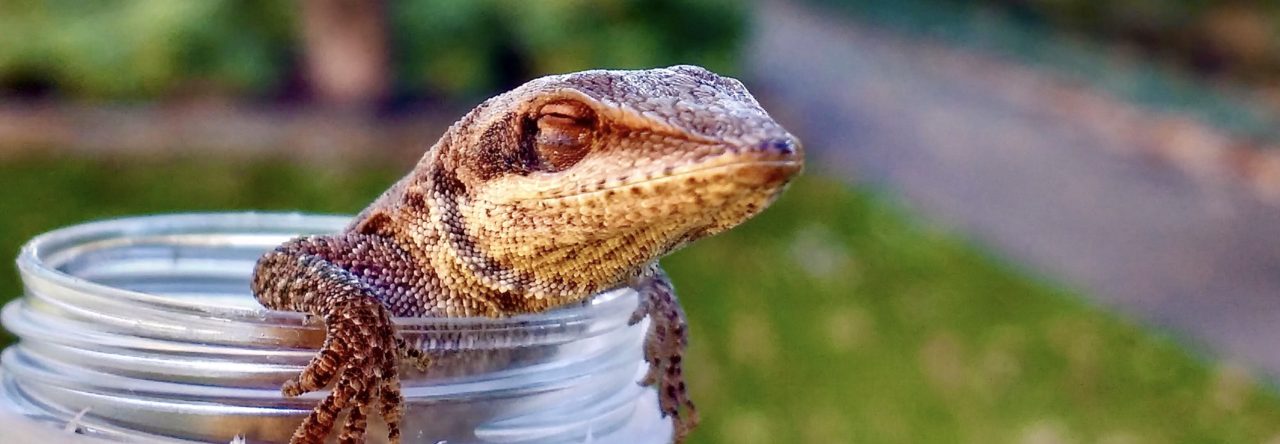Wrens seem like such harmless, friendly little birds. And with such a dainty little beak, how much damage could they do? Imagine our surprise, then, to learn that they may be voracious predators on our beloved anoles. Thanks to the observations of Roger Birkhead and Mark Benny, reported in the most recent issue of Herpetological Review, we now know the true nature of these little beasts. Here’s what they saw (Herpetological Review 45(1):123-124, 2014):
 “On 14 August 2013 around 0730 h MCB was observing the birdfeeders and birdhouses at his residence (Harrison Co., Mississippi, USA; 30.387325°N, 89.021624°W, datum WGS84/NAD83) when he noticed a commotion near the potted plants on his front porch. An adult Carolina Wren (Thryothorus ludovicianus) was observed smacking and shaking something large and elongated. When the wren flew up to the nearby birdhouse it became apparent that it had a juvenile Anolis carolinenis in its beak which it quickly fed to its chicks. This behavior was observed for a second time at approximately 1130 h. A third anole was observed being fed to the chicks at 1619 h (Fig. 1). There were at least two exchanges of food missed while leaving the point of observation to retrieve and set up a camera, but were evidenced by long green tails protruding from the entrance hole of the birdhouse that were longer than the lizard in Fig. 1. Adult wrens were also seen bringing larger unidentifiable pieces of flesh assumed be the remains of a larger dismembered A. carolinensis. Similar behavior has been noted for vireos feeding on A. carolinenis (Sykes et al. 2007. Wilson J. Ornithol. 119:508–510). Additional observations were made on 15 August and 16 August of both whole lizards and parts being brought in by the adult wrens. Lizards are identified in the diet of the Carolina Wren as far back as 1916 (Beal et al. 1916. Common Birds of the Southeastern United States in Relation to Agriculture. Farmers Bulletin 755, 40 pp.), but no species identifications were provided. Generally, predation of vertebrates by passerine birds is considered uncommon (Lopes et al. 2005. Lundiana 6:57–66). This observation is the first documented record of A. carolinensis being consumed by Carolina Wrens and judging by the frequency of captures noted here this wren species may be a significant predator of anoles at least during the bird’s nesting season.”
“On 14 August 2013 around 0730 h MCB was observing the birdfeeders and birdhouses at his residence (Harrison Co., Mississippi, USA; 30.387325°N, 89.021624°W, datum WGS84/NAD83) when he noticed a commotion near the potted plants on his front porch. An adult Carolina Wren (Thryothorus ludovicianus) was observed smacking and shaking something large and elongated. When the wren flew up to the nearby birdhouse it became apparent that it had a juvenile Anolis carolinenis in its beak which it quickly fed to its chicks. This behavior was observed for a second time at approximately 1130 h. A third anole was observed being fed to the chicks at 1619 h (Fig. 1). There were at least two exchanges of food missed while leaving the point of observation to retrieve and set up a camera, but were evidenced by long green tails protruding from the entrance hole of the birdhouse that were longer than the lizard in Fig. 1. Adult wrens were also seen bringing larger unidentifiable pieces of flesh assumed be the remains of a larger dismembered A. carolinensis. Similar behavior has been noted for vireos feeding on A. carolinenis (Sykes et al. 2007. Wilson J. Ornithol. 119:508–510). Additional observations were made on 15 August and 16 August of both whole lizards and parts being brought in by the adult wrens. Lizards are identified in the diet of the Carolina Wren as far back as 1916 (Beal et al. 1916. Common Birds of the Southeastern United States in Relation to Agriculture. Farmers Bulletin 755, 40 pp.), but no species identifications were provided. Generally, predation of vertebrates by passerine birds is considered uncommon (Lopes et al. 2005. Lundiana 6:57–66). This observation is the first documented record of A. carolinensis being consumed by Carolina Wrens and judging by the frequency of captures noted here this wren species may be a significant predator of anoles at least during the bird’s nesting season.”
- Evolution in Real Time on Lizard Island - March 23, 2025
- Spider Snags Adult Anolis osa - March 22, 2025
- An Homage to the Green Anoles of New Orleans - March 21, 2025


Jonathan Losos
A great summary of bird predation on anoles, by Powell and Henderson, is available for download.
Armando Pou
Very interesting; I’ve observed other small species of insectivorous birds eating anoles, especially during nesting season. Even generalists like small house sparrows bashing and then flying off with adult male A. sagrei (both exotics). I guess they can’t pass up the great protein source for their young.
Lana Kiland
I just about had a heart attack yesterday when I saw my 3/4 generation male wren brought a green anoles to the nesting area in an empty flower pot to feed the baby wrens! Fortunately for the anole, the wren dropped it on the concrete patio, then I made sure it made it’s escape to freedom. After sharing this with my husband today, he emailed me your article! I’m not sure I’m glad I know that the wrens do eat anoles or not, but thanks for your knowledge in knowing the truth!
Skip Lazell
My ornithologist colleague says this should be submitted to a peer-reviewed ornithological journal. Skip